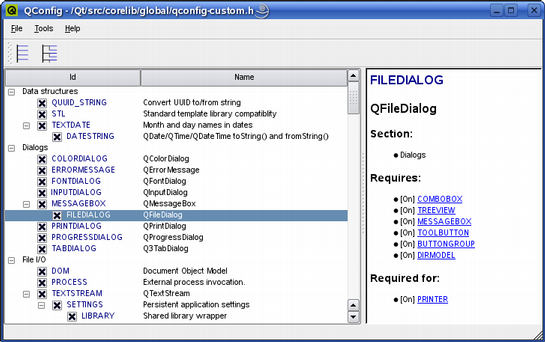- Accueil Actualités IT Pro
- Conception Cycle de vie du logiciel
- Java Plateforme et langage Java
- .NET Microsoft Framework .NET
- Dév. Web Développement Web et Webmarketing
- EDI Environnements de Développement Intégré
- Langages Langages de programmation applicatifs
- SGBD Systèmes de Gestion de Bases de Données
- Office Bureautique pour l'entreprise
- Solutions d'entreprise Autres logiciels pour l'entreprise
- Applications Applications logicielles
- Systèmes Logiciels et matériels systèmes
Fine-Tuning Features in QtIn many cases, only a fixed set of applications are deployed on an embedded device, making it possible to save resources by minimizing the size of the associated libraries. The Qt installation can easily be optimized by avoiding to compile in the features that are not required. A wide range of features are defined, covering classes and technologies provided by several of Qt's modules. You can look up the different feature definitions in the src/corelib/global/qfeatures.txt file within the Qt source distribution. Simple CustomizationEmbedded LinuxTo disable a particular feature, just run the configure script for Qt for Embedded Linux with the -no-feature-<feature> option. For example: ./configure -no-feature-thread The feature can easily be enabled again by running configure with the -feature-<feature> option. See also Qt Performance Tuning. Windows CETo disable a particular feature, just run the configure script with the set of required -D<feature> options. For example, you can use the -D option to define QT_NO_THREAD: configure.exe -D QT_NO_THREAD The -D option only creates a Qt internal define. If you get linker errors you have to define QT_NO_THREAD also for your project. You can do this by adding DEFINES += QT_NO_THREAD to your .pro file. See also Qt Performance Tuning. Managing Large Numbers of FeaturesIf you want to disable a lot of features, it is more comfortable to use the qconfig tool. You can disable a set of features by creating a custom configuration file that defines the preferred subset of Qt's functionality. Such a file uses macros to disable the unwanted features, and can be created manually or by using the qconfig tool located in the tools/qconfig directory of the Qt source distribution. Note: The qconfig tool is intended to be built against Qt on desktop platforms.
The qconfig tool's interface displays all of Qt's functionality, and allows the user to both disable and enable features. The user can open and edit any custom configuration file located in the src/corelib/global directory. When creating a custom configuration file manually, a description of the currently available Qt features can be found in the src/corelib/global/qfeatures.txt file. Note that some features depend on others; disabling any feature will automatically disable all features depending on it. The feature dependencies can be explored using the qconfig tool, but they are also described in the src/corelib/global/qfeatures.h file. To be able to apply the custom configuration, it must be saved in a file called qconfig-myfile.h in the src/corelib/global directory. Then use the configure tool's -qconfig option and pass the configuration's file name without the qconfig- prefix and .h extension, as argument. The following examples show how this is invoked on each of the embedded platforms for a file called qconfig-myfile.h: Embedded Linux: ./configure -qconfig myfile Windows CE: configure.exe -qconfig myfile Qt provides several ready-made custom configuration files, defining minimal, small, medium and large installations, respectively. These files are located in the /src/corelib/global directory in the Qt source distribution. © 2008-2011 Nokia Corporation and/or its subsidiaries. Nokia, Qt and their respective logos are trademarks of Nokia Corporation in Finland and/or other countries worldwide. All other trademarks are property of their respective owners. Privacy Policy Licensees holding valid Qt Commercial licenses may use this document in accordance with the Qt Commercial License Agreement provided with the Software or, alternatively, in accordance with the terms contained in a written agreement between you and Nokia. Alternatively, this document may be used under the terms of the GNU Free Documentation License version 1.3 as published by the Free Software Foundation. |




















